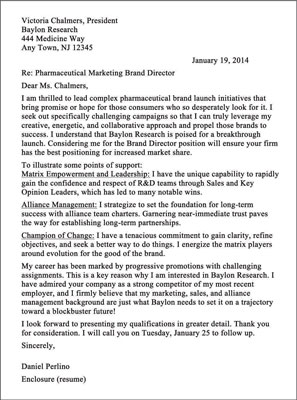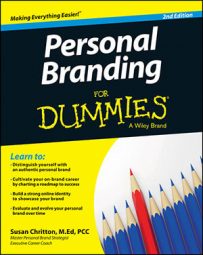Your cover letter or letter of introduction offers you the opportunity to connect with your reader in a more personal way using your personal brand than afforded in a resume. This letter differs from a branded bio because it’s more concise and formal, and it’s tailored to the specific work opportunity available.
In the letter, you can express your personal brand and point the reader to sections of your resume that you would like to draw attention to.
Write your cover letter in the first person and tailor it to each reader personally; you don’t want it to sound like a template. This is your opportunity to discuss your understanding of the targeted company’s issues and use past accomplishments to show your ability to solve similar problems. You want to be sure to promote your authentic self in the letter and show your strong value proposition.
Your cover letter may mirror much of what you’ve written in either the bio or the summary section of your resume. People often worry that they’re repeating themselves. As long as your materials are written well and send a clear message, repetition is fine!
Your job in the cover letter is to paint the picture for your reader of what you have to offer and to look interesting enough to compel the reader to spend time with your resume or bio.
Here are some fundamentals to keep in mind while writing the letter of introduction:
Let your personal brand shine through. (In doing so, you’ll let your personality shine through as well.)
Make sure that everything is spelled correctly and that you use proper punctuation.
Address the letter to a person whenever possible. Even if the job description asks you to send your materials to a blind box or to “Human Resources,” do some research and try to find out the name of the person you would report to if you got the job. Address the letter to that person, but be sure to follow directions and send it to where it’s requested.
Remember that your goal is to convey what you can do for the employer and how you will help solve their problems.
Summarize your experience, highlighting your best stuff.
Keep your letter to just one page.
Send references only when you’re asked and never write the phrase “references available upon request.” That fact is assumed, and the phrase is tired and outdated.
Proofread your letter before you send it! Read it aloud to yourself and listen to how it sounds. Ask someone else to proofread it as well.

Check out this cover letter. Note that his letter begins by emphasizing his brand attributes (“my creative, energetic, and collaborative approach”). He then highlights his strengths in the center of the letter, where he gives specific examples of what he can do. After providing an overview of his career, he ends with a statement of action (“I will call you on Tuesday, January 25th to follow up”).
If you’re sending a letter to a blind box or an HR department, meaning that you don't know exactly who to follow up with, you might substitute a sentence like, “I look forward to meeting or speaking with you soon.”

